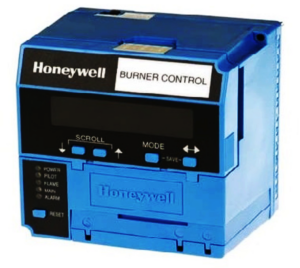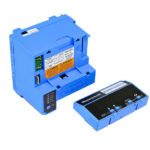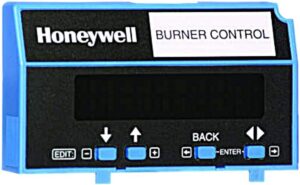Should You Upgrade from Honeywell RM7800 to the RM7823 or RM7890?
A Side-by-Side Comparison for Flame Safeguard Systems
The Honeywell RM7800 Series has long been a trusted standard in commercial and industrial burner management systems, providing reliable flame safeguard control across thousands of installations. Despite its proven track record, many facility managers and OEMs are now evaluating upgrade paths as newer models—such as the Honeywell RM7823 and RM7890—offer enhanced performance, simplified diagnostics, and greater compatibility with modern burner system requirements.
While the RM7800 remains widely supported and operational in the field, availability concerns and the push for improved system integration have led many to explore the advantages of transitioning to newer flame safeguard controllers. The RM7823 serves as a streamlined, cost-effective option for basic burner applications, whereas the RM7890 delivers additional capabilities, including remote reset, expanded diagnostics, and greater programming flexibility.
This article provides a side-by-side comparison of the RM7800, RM7823, and RM7890 controllers to help maintenance engineers, plant operators, and OEMs determine whether an upgrade makes sense for their system. We’ll outline compatibility, features, use cases, and retrofit considerations so you can make an informed decision when replacing or upgrading your Honeywell burner control system.
Quick Menu
Why Many Systems Still Use the Honeywell RM7800
The Honeywell RM7800 controller remains one of the most widely used flame safeguard solutions in the industrial heating market. Originally introduced as a modernized successor to older analog burner control units, the RM7800 quickly became a standard across commercial boilers, ovens, process heaters, and industrial furnaces. Its modular design, broad compatibility with flame amplifiers and programmers, and proven field reliability have made it the go-to controller for OEMs and service professionals for decades.
Thousands of burner systems continue to rely on the RM7800 flame safeguard controller because of its dependable operation and long-term availability. It integrates with the S7800A display module for limited diagnostics and lockout code visibility, helping maintenance teams troubleshoot issues without the need for external tools. Its solid-state design, universal mounting base, and wide range of application-specific programmer modules also contribute to its enduring presence in the field.
However, as system demands evolve, the RM7800’s limitations are more apparent. Native communication options are minimal, diagnostics are basic by today’s standards, and remote reset capabilities require additional hardware. While it continues to serve reliably in legacy installations, facilities looking to enhance monitoring, reduce downtime, or integrate with building automation systems often begin evaluating newer Honeywell controllers like the RM7823 or RM7890 as part of their long-term upgrade strategy.
Understanding the Differences: RM7800 vs RM7823 vs RM7890
When evaluating whether to upgrade your Honeywell flame safeguard system, it’s essential to understand the functional and operational differences between the RM7800, RM7823, and RM7890 controllers. While all three units perform core burner safety functions—such as flame detection, safe startup sequencing, and lockout—they are optimized for different applications and levels of system complexity.
The RM7800 is the most versatile of the three, designed for a broad range of burner types and featuring modular compatibility with programmer and amplifier modules. It supports the S7800A display for basic diagnostics, but communication and remote access capabilities are limited without added modules.
The RM7823 is a simplified, fixed-sequence controller intended for cost-sensitive or small commercial applications. It has fewer programmable features and no communication interface, making it a solid choice for basic single-burner systems where advanced diagnostics or remote reset aren’t required.
The RM7890 strikes a balance between the two. It offers improved fault isolation, optional remote reset, and enhanced diagnostic outputs. Unlike the RM7823, the RM7890 supports limited programmability and more sophisticated flame safeguard features, making it suitable for mid-tier industrial environments.
The decision to upgrade often comes down to application requirements, integration needs, and budget. The table below provides a side-by-side comparison to help you determine which controller is best suited for your system.
RM7800 vs RM7823 vs RM7890 – Feature Comparison Table
| Feature | Honeywell RM7800 | Honeywell RM7823 | Honeywell RM7890 |
|---|---|---|---|
| Sample Part Number | RM7840L1075
RM7840G1018 |
RM7823A1016
|
RM7890A1059 |
| Most Common Application | Commercial/industrial boilers, process burners, kilns | Basic atmospheric boilers, small furnaces, unit heaters | Mid-range commercial burners, packaged systems, small industrial plants |
| Controller Type | Modular, programmable | Fixed-sequence, non-programmable | Semi-programmable with advanced diagnostics |
| Display Capability | Yes (via S7800A display module) | No | Yes (basic built-in fault codes) |
| Remote Reset | Optional (with additional modules) | Not supported | Optional (select models support remote reset) |
| Flame Detection | Yes (uses interchangeable amplifiers) | Yes (fixed flame amplifier) | Yes (supports UV and flame rod detection) |
| Diagnostics | Basic (external display required) | Minimal (LED lockout only) | Improved (internal diagnostics + LED codes) |
| Modularity | Fully modular (amplifiers, programmers, bases) | Limited | Partial (uses same bases but fewer compatible modules) |
| Communication Options | Optional (via expanded modules) | Not supported | Limited built-in (no full BACnet/Modbus) |
| Lockout Timing | Selectable with programmer modules | Fixed | Preset but varies by model |
| Typical Budget | $$$ (mid-to-high) | $ (low-cost option) | $$ (mid-range) |
| Availability | Still stocked widely | Readily available | Readily available |
| Best Use Case | Sites requiring flexibility, module customization, or integration | Low-cost systems needing reliable safety control without extras | Operators seeking diagnostics and basic remote capabilities without full automation system overhaul |
Compatible flame amplifiers for each Honeywell controller series:
Honeywell RM7800 Series – Compatible Flame Amplifiers
• R7847 (Rectification)
• R7848 (Ultraviolet)
• R7849 (Infrared, Dynamic Self-Check)
• R7851 (Infrared, Non Self-Check)
Honeywell RM7823 Series – Flame Amplifier
• Internal fixed amplifier
• Factory-configured for either rectification or UV (varies by part number)
• Not modular or field-replaceable
Honeywell RM7890 Series – Compatible Flame Amplifiers
• R7847 (Rectification)
• R7848 (Ultraviolet)
• R7849 (Infrared, Dynamic Self-Check)
• R7851 (Infrared, Non Self-Check)
Choosing the Right Upgrade Path
Upgrading from the Honeywell RM7800 to either the RM7823 or RM7890 depends on your application complexity, diagnostic needs, and compliance requirements. Both the RM7823 and RM7890 offer safe, reliable burner control, but they serve distinct roles in the field.
The RM7823 is best suited for cost-sensitive, straightforward burner applications where advanced diagnostics or system integration aren’t necessary. It offers fixed operational sequences, a built-in flame amplifier, and minimal setup—ideal for small atmospheric boilers, unit heaters, or single-stage burners. For many retrofit projects where budget is a primary concern and the burner control system is not expected to communicate with external devices, the RM7823 is a streamlined, drop-in solution.
In contrast, the RM7890 is the better choice when your operation requires remote reset capabilities, improved diagnostic visibility, or plans to interface with basic automation systems. It provides internal fault codes, supports field-replaceable amplifiers, and maintains compatibility with a variety of flame sensors and programmer modules. If your site is aiming to reduce downtime, improve lockout tracking, or future-proof your burner management system, the RM7890 offers more operational value.
Before upgrading, it’s critical to assess peripheral compatibility—including flame sensors, amplifiers (R7847, R7848, R7849, R7851), and programmer modules. Ensure your chosen replacement controller supports your system’s flame detection method (UV or rectification) and matches the timing and lockout behavior expected by your burner system.
Upgrade Considerations & Change Control
When planning a burner management system upgrade, it’s essential to account for both technical compatibility and procedural change control requirements. While Honeywell retrofit controllers like the RM7823 and RM7890 are designed for ease of replacement, not all transitions are drop-in by default.
In many cases, the RM7823 and RM7890 can be installed directly onto the existing RM7800 subbase, using the same mounting footprint and terminal layout. However, compatibility depends on your flame amplifier, programmer module, and system wiring. For example, the RM7823’s internal amplifier cannot be swapped, and its lockout timing is fixed—this could impact burner sequences that rely on custom timing logic. The RM7890 provides broader compatibility but still requires verification of peripheral devices. And The Honeywell RM‑7800 “2000 Series” relay module (e.g., RM7897C2000) and corresponding sub‑bases include a built-in grounding pin feature designed to ensure proper earth reference and structural stability of the unit. Here’s how it works:
UL and CSA compliance should also be reviewed during the upgrade process, especially if your system is governed by insurance inspection standards or local code enforcement. Using listed and approved controllers ensures that your retrofit maintains safety certifications.
Avoiding unexpected burner shutdowns is another key consideration. Schedule upgrades during planned maintenance windows, and verify flame signal strength and lockout behavior before returning the system to service.
From a logistics standpoint, ensure your chosen controller is readily available—lead times can vary depending on model, supply chain conditions, and regional demand. Ordering from a Honeywell-authorized distributor with in-stock availability reduces downtime and avoids project delays. Also, budget appropriately: RM7823 models are more economical, while RM7890 units are moderately priced but offer greater functionality.
Proper planning, part verification, and coordination with your maintenance or compliance team will make the upgrade process smoother and more reliable.
Our Recommendation as a Distributor
As a stocking distributor of Honeywell flame safeguard controllers, we’ve supported hundreds of customers through RM7800 upgrade projects—ranging from boiler rooms in schools to industrial process burners in manufacturing facilities. Based on supply trends and customer feedback, we regularly stock the RM7890A1059 and RM7823A1013 as the most common upgrade paths from the RM7800 series.
Most facilities upgrading from the RM7800 lean toward the RM7890. It offers the best balance between compatibility, diagnostic improvement, and future readiness. Plant technicians appreciate its ability to retain existing bases and amplifiers, while gaining features like built-in LED fault codes and optional remote reset. Customers operating multiple burners in parallel also prefer the RM7890 because it reduces troubleshooting time and supports a more standardized platform.
The RM7823, on the other hand, is a great fit for low-complexity burner systems that don’t need advanced communication or programming. It’s especially popular with contractors servicing small commercial boilers who want a reliable, no-frills controller at a lower price point.
From the field, technicians consistently tell us: “If you want a simple upgrade with minimal rewiring, go RM7890. It gives you the most without changing your whole system.” That’s why it’s our top recommendation for most RM7800 replacements.
If you’re unsure which model fits your system best, our team can help verify compatibility and assist with amplifier or subbase selection.
FAQ: Honeywell Flame Safeguard Upgrade Guide
Is the RM7800 obsolete?
No, but certain variants are becoming harder to source. Many OEMs now design around the RM7890 or similar models due to improved functionality, diagnostic capabilities, and long-term availability. The RM7800 is still supported, but forward-looking facilities are planning phased upgrades.
Is the RM7890 a direct replacement for RM7800?
Yes, in many cases it can be installed on the same wiring subbase, especially if the same amplifier and sensor type are used. However, it’s important to confirm software logic, timing behavior, and flame amplifier compatibility during the retrofit process.
Can I upgrade to RM7823 without other changes?
Yes, as long as your burner system is simple and does not require programmable timing, remote reset, or external diagnostics. The RM7823 offers a fixed-sequence flame safeguard function with built-in amplification, making it ideal for smaller, standalone heating systems.
Do I need to change my flame amplifier when upgrading?
Not always. The RM7890 supports the same R7847, R7848, R7849, and R7851 flame amplifiers used with the RM7800. The RM7823, however, uses an integrated amplifier, so external amplifier replacement is not applicable or possible in that case.
Can I use my existing programmer module?
In some cases, yes. Many programmer modules used with the RM7800 can be reused with the RM7890. However, since the RM7823 has a fixed internal sequence, it does not accept external programmer modules.
Will I need a new display module?
The RM7800 and RM7890 can both interface with the Honeywell S7800A display module for lockout code and system status. The RM7823 does not support external displays or communication interfaces.







